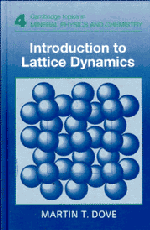Book contents
- Frontmatter
- Contents
- Preface
- Acknowledgements
- Physical constants and conversion factors
- 1 Some fundamentals
- 2 The harmonic approximation and lattice dynamics of very simple systems
- 3 Dynamics of diatomic crystals: general principles
- 4 How far do the atoms move?
- 5 Lattice dynamics and thermodynamics
- 6 Formal description
- 7 Acoustic modes and macroscopic elasticity
- 8 Anharmonic effects and phase transitions
- 9 Neutron scattering
- 10 Infrared and Raman spectroscopy
- 11 Formal quantum-mechanical description of lattice vibrations
- 12 Molecular dynamics simulations
- A The Ewald method
- B Lattice sums
- C Bose-Einstein distribution and the thermodynamic relations for phonons
- D Landau theory of phase transitions
- E Classical theory of coherent neutron scattering
- F Time correlation functions
- G Commutation relations
- H Published phonon dispersion curves for non-metallic crystals: update of previous compilation
- References
- Index
1 - Some fundamentals
Published online by Cambridge University Press: 17 February 2010
- Frontmatter
- Contents
- Preface
- Acknowledgements
- Physical constants and conversion factors
- 1 Some fundamentals
- 2 The harmonic approximation and lattice dynamics of very simple systems
- 3 Dynamics of diatomic crystals: general principles
- 4 How far do the atoms move?
- 5 Lattice dynamics and thermodynamics
- 6 Formal description
- 7 Acoustic modes and macroscopic elasticity
- 8 Anharmonic effects and phase transitions
- 9 Neutron scattering
- 10 Infrared and Raman spectroscopy
- 11 Formal quantum-mechanical description of lattice vibrations
- 12 Molecular dynamics simulations
- A The Ewald method
- B Lattice sums
- C Bose-Einstein distribution and the thermodynamic relations for phonons
- D Landau theory of phase transitions
- E Classical theory of coherent neutron scattering
- F Time correlation functions
- G Commutation relations
- H Published phonon dispersion curves for non-metallic crystals: update of previous compilation
- References
- Index
Summary
We begin by describing the interatomic forces that cause the atoms to move about. The main interactions that we will use later on are defined, and methods for the determination of specific interactions are discussed. The second part of the chapter is concerned with the behaviour of travelling waves in any crystal.
Indications that dynamics of atoms in a crystal are important: failure of the static lattice approximation
Crystallography is generally concerned with the static properties of crystals, describing features such as the average positions of atoms and the symmetry of a crystal. Solid state physics takes a similar line as far as elementary electronic properties are concerned. We know, however, that atoms actually move around inside the crystal structure, since it is these motions that give the concept of temperature, and the structures revealed by X-ray diffraction or electron microscopy are really averaged over all the motions. The only signature of these motions in the traditional crystallographic sense is the temperature factor (otherwise known as the Debye–Waller factor (Debye 1914; Waller 1923, 1928) or displacement amplitude), although diffuse scattering seen between reciprocal lattice vectors is also a sign of motion (Willis and Pryor 1975). The static lattice model, which is only concerned with the average positions of atoms and neglects their motions, can explain a large number of material features, such as chemical properties, material hardness, shapes of crystals, optical properties, Bragg scattering of X-ray, electron and neutron beams, electronic structure and electrical properties, etc.
- Type
- Chapter
- Information
- Introduction to Lattice Dynamics , pp. 1 - 17Publisher: Cambridge University PressPrint publication year: 1993

